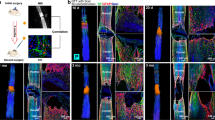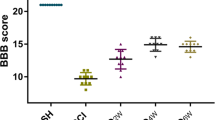Abstract
Prognosis and treatment evaluation of spinal cord injury (SCI) are still in the long-term research stage. Prognostic factors for SCI treatment need effective biomarker to assess therapeutic effect. Quantitative diffusion tensor imaging (DTI) may become a potential indicators for assessing SCI repair. However, its correlation with the results of locomotor function recovery and tissue repair has not been carefully studied. The aim of this study was to use quantitative DTI to predict neurological repair of SCI with transplanting collagen/chitosan scaffold binding basic fibroblast growth factor (bFGF). To achieve our research goals, T10 complete transection SCI model was established. Then collagen/chitosan mixture adsorbed with bFGF (CCS/bFGF) were implanted into rats with SCI. At 8 weeks after modeling, implanting CCS/bFGF demonstrated more significant improvements in locomotor function according to Basso-Beattie-Bresnahan (BBB) score, inclined-grid climbing test, and electrophysiological examinations. DTI was carried out to evaluate the repair of axons by diffusion tensor tractgraphy (DTT), fractional anisotropy (FA) and apparent diffusion coefficient (ADC), a numerical measure of relative white matter from the rostral to the caudal. Parallel to locomotor function recovery, the CCS/bFGF group could significantly promote the regeneration of nerve fibers tracts according to DTT, magnetic resonance imaging (MRI), Bielschowsky’s silver staining and immunofluorescence staining. Positive correlations between imaging and locomotor function or histology were found at all locations from the rostral to the caudal (P < 0.0001). These results demonstrated that DTI might be used as an effective predictor for evaluating neurological repair after SCI in experimental trails and clinical cases.










Similar content being viewed by others
References
Saxena T, Loomis KH, Pai BS, Karumbaiah L, Gaupp E, Patil K, et al. Nanocarrier mediated inhibition of macrophage migration inhibitory factor attenuates secondary injury after spinal cord injury. ACS Nano. 2015;9:1492–505.
Devivo MJ, Krause JS, Lammertse DP. Recent trends in mortality and causes of death among persons with spinal cord injury. Arch Phys Med Rehabil. 1999;80:1411–9.
Oliveira AL, Sousa EC, Silva NA, Sousa N, Salgado AJ, Reis RL. Peripheral mineralization of a 3D biodegradable tubular construct as a way to enhance guidance stabilization in spinal cord injury regeneration. J Mater Sci Mater Med. 2012;23:2821–30.
Li G, Che MT, Zhang K, Qin LN, Zhang YT, Chen RQ, et al. Graft of the NT-3 persistent delivery gelatin sponge scaffold promotes axon regeneration, attenuates inflammation, and induces cell migration in rat and canine with spinal cord injury. Biomaterials. 2016;83:233–48.
Hejčl A, Růžička J, Proks V, Macková H, Kubinová Š, Tukmachev D, et al. Dynamics of tissue ingrowth in SIKVAV-modified highly superporous PHEMA scaffolds with oriented pores after bridging a spinal cord transection. J Mater Sci Mater Med. 2018;29:89.
Nd HE, Tuszynski MH. Neurotrophins: potential therapeutic tools for the treatment of spinal cord injury. Neurotherapeutics. 2011;8:694–703.
Mccall J, Weidner N, Blesch A. Neurotrophic factors in combinatorial approaches for spinal cord regeneration. Cell Tissue Res. 2012;349:27–37.
Shi Q, Gao W, Han X, Zhu X, Sun J, Xie F, et al. Collagen scaffolds modified with collagen-binding bFGF promotes the neural regeneration in a rat hemisected spinal cord injury model. Sci China Life Sci. 2014;57:232–40.
Oliveri RS, Segun B, Fin BS. Mesenchymal stem cells improve locomotor recovery in traumatic spinal cord injury: systematic review with meta-analyses of rat models. Neurobiol Dis. 2014;62:338–53.
Raspa A, Pugliese R, Maleki M, Gelain F. Recent therapeutic approaches for spinal cord injury. Biotechnol Bioeng. 2016;113:253–9.
Fakhoury M. Spinal cord injury: overview of experimental approaches used to restore locomotor activity. Rev Neurosci. 2015;26:397–405.
Elizei SS, Kwon BK. The translational importance of establishing biomarkers of human spinal cord injury. Neural Regen Res. 2017;12:385–8.
Yung A, Mattucci S, Bohnet B, Liu J, Fournier C, Tetzlaff W, et al. Diffusion tensor imaging shows mechanism-specific differences in injury pattern and progression in rat models of acute spinal cord injury. Neuroimage. 2018;186:43–55.
Wang-Leandro A, Hobert MK, Kramer S, Rohn K, Stein VM, Tipold A. The role of diffusion tensor imaging as an objective tool for the assessment of motor function recovery after paraplegia in a naturally-occurring large animal model of spinal cord injury. J Transl Med. 2018;16:258.
Kim J, Song SK, Burke DA, Magnuson DSK. Comprehensive locomotor outcomes correlate to hyperacute diffusion tensor measures after spinal cord injury in the adult rat. Exp Neurol. 2012;235:188–96.
Wang X, Duffy P, McGee AW, Hasan O, Gould G, Tu N, et al. Recovery from chronic spinal cord contusion after Nogo receptor intervention. Ann Neurol. 2011;70:805–21.
Shanmuganathan K, Gullapalli RP, Zhuo J, Mirvis SE. Diffusion tensor MR imaging in cervical spine trauma. AJNR Am J Neuroradiol. 2008;29:655–9.
Ellingson BM, Ulmer JL, Kurpad SN, Schmit BD. Diffusion tensor MR imaging in chronic spinal cord injury. AJNR Am J Neuroradiol. 2008;29:1976.
Loy DN, Kim JH, Xie M, Schmidt RE, Trinkaus K, Song SK. Diffusion tensor imaging predicts hyperacute spinal cord injury severity. J Neurotrauma. 2007;24:979–90.
Zhao C, Rao JS, Pei XJ, Lei JF, Wang ZJ, Yang ZY, et al. Longitudinal study on diffusion tensor imaging and diffusion tensor tractography following spinal cord contusion injury in rats. Neuroradiology. 2016;58:607–14.
Ellingson BM, Salamon N, Holly LT. Imaging techniques in spinal cord injury. World Neurosurg. 2014;82:1351–8.
Fujiyoshi K, Konomi T, Yamada M, Hikishima K, Tsuji O, Komaki Y, et al. Diffusion tensor imaging and tractography of the spinal cord: from experimental studies to clinical application. Exp Neurol. 2013;242:74–82.
Xu J, Shimony JS, Klawiter EC, Snyder AZ, Trinkaus K, Naismith RT, et al. Improved in vivo diffusion tensor imaging of human cervical spinal cord. Neuroimage. 2013;67:64–76.
Poretti A, Meoded A, Bunge M, Fatemi A, Barrette P, Huisman TA, et al. Novel diffusion tensor imaging findings in Krabbe disease. Eur J Paediatr Neurol. 2014;18:150–6.
Koskinen EA, Hakulinen U, Brander AE, Luoto TM, Ylinen A, Ohman JE. Clinical correlates of cerebral diffusion tensor imaging findings in chronic traumatic spinal cord injury. Spinal Cord. 2014;52:202–8.
Bodley R. Imaging in chronic spinal cord injury–indications and benefits. Eur J Radiol. 2002;42:135–53.
Schwartz ED, Yezierski RP, Pattany PM, Quencer RM, Weaver RG. Diffusion-weighted MR imaging in a rat model of syringomyelia after excitotoxic spinal cord injury. AJNR Am J Neuroradiol. 1999;20:1422–8.
Blomster LV, Cowin GJ, Kurniawan ND, Ruitenberg MJ. Detection of endogenous iron deposits in the injured mouse spinal cord through high-resolution ex vivo and in vivo MRI. NMR Biomed. 2013;26:141–50.
Zhao C, Rao JS, Pei XJ, Lei JF, Wang ZJ, Zhao W, et al. Diffusion tensor imaging of spinal cord parenchyma lesion in rat with chronic spinal cord injury. Magn Reson Imaging. 2018;47:25–32.
Rajasekaran S, Kanna RM, Shetty AP, Ilayaraja V. Efficacy of diffusion tensor anisotropy indices and tractography in assessing the extent of severity of spinal cord injury: an in vitro analytical study in calf spinal cords. Spine J. 2012;12:1147–53.
Wang F, Huang SL, He XJ, Li XH. Determination of the ideal rat model for spinal cord injury by diffusion tensor imaging. Neuroreport. 2014;25:1386–92.
Jirjis MB, Kurpad SN, Schmit BD. Ex vivo diffusion tensor imaging of spinal cord injury in rats of varying degrees of severity. J Neurotrauma. 2013;30:1577–86.
Kelley BJ, Harel NY, Kim CY, Papademetris X, Coman D, Wang X, et al. Diffusion tensor imaging as a predictor of locomotor function after experimental spinal cord injury and recovery. J Neurotrauma. 2014;31:1362–73.
Li XH, Li JB, He XJ, Wang F, Huang SL, Bai ZL. Timing of diffusion tensor imaging in the acute spinal cord injury of rats. Sci Rep. 2015;5:12639.
Basser PJ, Pierpaoli C. Microstructural and physiological features of tissues elucidated by quantitative-diffusion-tensor MRI. J Magn Reson. 2011;213:560–70.
Yoo WK, Kim TH, Hai DM, Sundaram S, Yang YM, Park MS, et al. Correlation of magnetic resonance diffusion tensor imaging and clinical findings of cervical myelopathy. Spine J. 2013;13:867–76.
Sun Y, Yang C, Zhu X, Wang JJ, Liu XY, Yang XP, et al. 3D printing collagen/chitosan scaffold ameliorated axon regeneration and neurological recovery after spinal cord injury. J Biomed Mater Res A. 2019;107(9):1898–908.
Fu F, Zhu X, Qin Z, Wang JJ, Xu C, Wang LN, et al. Differential degradation rate and underlying mechanism of a collagen/chitosan complex in subcutis, spinal cord and brain tissues of rat. J Mater Sci Mater Med. 2018;29:35.
Harris J, Lee H, Tu CT, Cribbs D, Cotman C, Jeon NL. Preparing e18 cortical rat neurons for compartmentalization in a microfluidic device. J Visualized Exp. 2007;8:305.
Chen C, Zhao M, Zhang R, Lu G, Zhao C, Fu F, et al. Collagen/heparin sulfate scaffolds fabricated by a 3D bioprinter improved mechanical properties and neurological function after spinal cord injury in rats. J Biomed Mater Res Part A. 2017;105:1324–32.
Basso DM, Beattie MS, Bresnahan JC. A sensitive and reliable locomotor rating scale for open field testing in rats. J Neurotrauma. 1995;12:1.
RamãN-Cueto A, Cordero MI, Santos-Benito FF, Avila J. Functional recovery of paraplegic rats and motor axon regeneration in their spinal cords by olfactory ensheathing glia. Neuron. 2000;25:425–35.
Rivlin AS, Tator CH. Objective clinical assessment of motor function after experimental spinal cord injury in the rat. J Neurosurg. 1977;47:577–81.
Bazley FA, Hu C, Maybhate A, Pourmorteza A, Pashai N, Thakor NV, et al. Electrophysiological evaluation of sensory and motor pathways after incomplete unilateral spinal cord contusion. J Neurosurg Spine. 2012;16:414–23.
Xu X, Li N, Zhu L, Zhou Y, Cheng H. Beneficial effects of local profound hypothermia and the possible mechanism after experimental spinal cord injury in rats. J Am Paraplegia Soc. 2015;39:220–8.
Sedý J, Urdzíková L, Jendelová P, Syková E. Methods for behavioral testing of spinal cord injured rats. Neurosci Biobehav Rev. 2008;32:550–80.
Li XF, Dai LY. Three-dimensional finite element model of the cervical spinal cord: preliminary results of injury mechanism analysis. Spine. 2009;34:1140–7.
Huang SL, Liu YX, Yuan GL, Zhang J, Yan HW. Characteristics of lumbar disc herniation with exacerbation of presentation due to spinal manipulative therapy. Medicine. 2015;94:e661.
Huang SL, He XJ, Xiang L, Yuan GL, Ning N, Lan BS. CT and MRI features of patients with diastematomyelia. Spinal Cord. 2014;52:689–92.
Bosma R, Stroman PW. Diffusion tensor imaging in the human spinal cord: development, limitations, and clinical applications. Crit Rev Biomed Eng. 2012;40:1–20.
Li W, Long Y, Liu Y, Long K, Liu S, Wang Z, et al. Fabrication and characterization of chitosan-collagen crosslinked membranes for corneal tissue engineering. J Biomater Sci Polym Ed. 2014;25:1962–72.
Takagi T, Kimura Y, Shibata S, Saito H, Ishii K, Okano HJ, et al. Sustained bFGF-release tubes for peripheral nerve regeneration: comparison with autograft. Plast Reconstructive Surg. 2012;130:866–76.
Acknowledgements
This work was supported by the National Nature Scientific Fund of China (81771352, 81971782, 81671222, 81771350, 81772018, 81801240) and the Nature Scientific Fund of Tianjin (18JCJQJC48500, 15ZXLCSY00040, 16ZXHLSY00120).
Author information
Authors and Affiliations
Corresponding authors
Ethics declarations
Conflict of interest
The authors declare that they have no conflict of interest.
Additional information
Publisher’s note Springer Nature remains neutral with regard to jurisdictional claims in published maps and institutional affiliations.
Rights and permissions
About this article
Cite this article
Liu, XY., Liang, J., Wang, Y. et al. Diffusion tensor imaging predicting neurological repair of spinal cord injury with transplanting collagen/chitosan scaffold binding bFGF. J Mater Sci: Mater Med 30, 123 (2019). https://doi.org/10.1007/s10856-019-6322-y
Received:
Accepted:
Published:
DOI: https://doi.org/10.1007/s10856-019-6322-y




